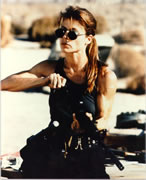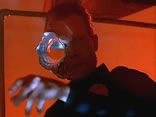James Cameron Terminator 2: Judgment Day (Part II)

Written by
James Cameron
and
William Wisher
Continuing the interview with James Cameron, on the origins of Terminator 2: Judgment Day. (Read Part I)
![]()
“Basically, what I wanted to say in Terminator 2 was that everything is meant to be a certain way, everything has already been written. You can call it karma or destiny, whatever.”
So I asked myself a hypothetical question: what if you could you grab a line of history like it’s a rope stretched between two points, and just pull it out of the way? If you can pull it just a little bit out of the way then cut it at that moment, maybe you could change it and history could go in a slightly different direction. Like the catastrophe theory. If you could actually do that you would get a future that no longer exists except in the memories of the people who are here now. They have a memory of a future that will never happen, which is curious, because it defies our Newtonian view of the world. But couldn’t it be possible?
That became my point of departure. It’s like the Terminator is an anomaly of our time because he’s the only one who has memories of a time that will never exist. His particular future does not exist anymore.
In Terminator, the first script, I wrote a scene where Sarah is driving talking to herself on the tape machine, and she says, ‘If I had done this then this would have happened, and if I did that then that would have happened and then I wouldn’t have even existed, and I could go crazy thinking about it. I just have to deal with what’s in front of me.’
As I got ready to write the screenplay, I kept asking myself, ‘What’s the real goal of this movie? Are we going to blow people away and get them all excited? Is that it? Or is there a way we can get them to really feel something?’ I thought it would be a real coup if we could get people to cry for a machine. If we could get people to cry for Arnold Schwarzenegger playing a robot, that would be terrific.
That was the fun of the whole thing. It wasn’t all the chases and special effects and all that stuff, though I get off on that on a day-to-day basis. I love sitting at the editing machine and making cuts and getting the action working, but when I look back I think the real thrill was being able to control a response that was totally opposite from what we got the first time. And to just have fun with that. To play against expectations. You’ve got to do that, especially in a sequel.

Knowing what John had to do in the future, Sarah would begin telling him this stuff as soon as he could talk. John was going to become leader of the world, so he’s going to have to shoulder the responsibility of the entire human race. John grew up on a diet of knowing what he had to become. And he resented the hell out of it.
By the time he’s ten years old he had spent his years of childhood thinking and knowing what his future was going to be. He knows, from his future experience, that killing is bad for you. Because the Terminator was sent from the future by the leader John, to protect the child John, so the boy’s character has to be woven with a strong moral fiber. The fact that the Terminator was ordered not to kill people becomes a major point of the story.
We liked the idea of the kid, but we didn’t know what to do about the Terminator. For a while we thought about having a double Terminator, kind of a double Arnold, but thought it might get too complicated, so we discounted it. Then we had one of those ‘no-brainer’ ideas one day; why not have the Terminator reprogrammed to play good Terminator. We knew we could have some fun with that. We wanted him to change, and we wanted Sarah to change; she starts out one way, becomes fixated on that, ends up becoming more of a machine that he does. We wanted the two of them to change characters as the film went on: she becomes the Terminator while he becomes a human being. And it’s partly through the Terminator’s transformation that she understands what humanity really is.
In the first film, the Terminator is just a force. The ultimate killing machine. He’s not really a character; he’s the embodiment of the ultimate tidal wave, or earthquake, or lightning bolt, or heart attack, the thing you cannot stop. But now, if Arnold was the “good guy,” who was the “bad guy?” How were we going to do this?

But there had to be limits about his shape-changing. Could it turn into a Coca-Cola machine? No, because it can’t change its mass. It certainly can’t change its weight; weight and mass are two physical constants. But it can become things. It could not turn into a small dog because it was too big, there was too much mass, too much material. It could mimic weapons, but it couldn’t mimic a weapon that would actually fire. A gun has moving parts, and there’s gunpowder inside a brass shell, so it can’t make itself into that.
So we said, okay, it can’t make itself into a gun, but it could certainly make itself into a knife. Or something flat, like linoleum. Knowing it could be a knife, we needed to show that once or twice because it would look cool, and we figured we could fit that into several different situations.
We’d be writing a sequence, for example, like Sarah’s escape from Pescadero, in which the T-1000 steps through the bars. But if he steps through them, it would be nice to let everyone know that he’s really stepping through them; so we let the gun get caught up in the bars. He has to reach down and adjust it to get it through.
How could we accomplish this? To begin with, there’s an area that the computer graphics guys have been working in for a long time called ‘human motion animation.’ It’s been proven to be one of the hardest sciences, because the eye and the brain inherently know what is right or not right about human beings. There’s nothing in the world we know more about than the human being. How they move, how they talk, how they smell, how they stand, all of that. We know that at some innate level you can’t fool the human eye. So simulating human motion from scratch, mathematically, is very difficult.
The start point in CGI is always the final form. I wanted the effect of the T-1000 to look like a spoon going into hot fudge; it dimples down, then flows up over and closes. That’s the look I wanted. You have to work with the viscosity in order to get that look just right. You have to figure out what the closure looks like. Does the color come back immediately, or is there a lag time between where the surface forms and then the color forms after that? We had to create a visual language for this guy. For example, when he forms up from his chrome shape, does he form up with the colors of his uniform and skin and all those things simultaneously? I finally chose to have him assume the absolute finished form in a kind of liquid chrome, and then have the color of this uniform be the last thing added. We emphasized the idea that the T-1000 was mimetic, that it was a camouflage technique in the way a chameleon would imitate a color it’s sitting on, which is why we made up a name for him, a mimetic poly alloy; the ultimate chameleon.
Because of the time constraints [they only had six weeks to write the script] we kicked it around a bit, then sat down and wrote. We paced around, talked it out, then hit the keyboard. In the first act we knew we had to have the players on the board and identified. So who was going to be first? Should we introduce Sarah first, or go with John first? We knew in very thick blocks what we had to do. So we sat down and asked, How do we start? Where do we enter the sequence?
We started tossing around ideas: What’s the idea for this scene? For that scene? And any time one of us had an idea we would talk about it, then one of us would sit down and write. When we got tired, we’d trade places and continue typing. We gave every scene a separate file; we had a file for the nuclear blast scene, for Sarah’s escape from the hospital, for the kid robbing the ATM machine, and so on.
We kept the hammer down, forcing ourselves to produce. ‘Let’s just make scenes,’ I said, ‘just keep it flowing. If it’s shit, we’ll throw it out later.’ And as the deadline loomed, the nights got longer.
The last twenty-five pages of the script were written nonstop, and when I finally gave the computer the print command to spit out the entire script, the limo was waiting in the driveway to take me to the airport so we could announce the film at Cannes. We had been up for thirty-six hours straight.

I like to lead the audience; so when the audience thinks the film is over that’s when they’re thrust into a whole new territory that heightens the emotional experience. If you, as a screenwriter, can create certain ground rules and get the audience into your rhythm, you can get them right out to the end of the dock, then give them a big kick in the ass and they’re going to suddenly find themselves in a new place where they never thought the journey was going to take them.
People ask me all the time how I became a film director. And I tell them that if you have to ask somebody how to be a film director, you’ll probably never do it. If that pisses you off, and then you go out and say, ‘I’m going to show that Jim Cameron; I am going to be a director,’ that gives you the kind of true grit you need to have in order to go through with it. And if you do become a film director, then you should send me a bottle of champagne and thank me.”

Comments are closed.